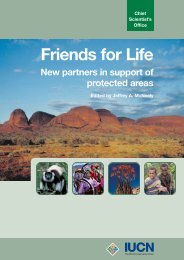Exchange programmes - IUCN
Exchange programmes - IUCN
Exchange programmes - IUCN
You also want an ePaper? Increase the reach of your titles
YUMPU automatically turns print PDFs into web optimized ePapers that Google loves.
Implementation of an <strong>Exchange</strong> Programme for Protected Areas in East Asia<br />
best global source of information published by the <strong>IUCN</strong> is the UN List of Protected Areas<br />
1997 (<strong>IUCN</strong>, 1998) 1 . One approach to lookingfor a partner is for a protected area<br />
manager to summarise the characteristics of his or her own protected area and decide what<br />
type of partner would serve the needs best. Criteria to be considered in selectinga partner<br />
are set out in Box 2.2.<br />
Box 2.2 Criteria for selecting an appropriate partner<br />
� similar landscape and ecosystem type (e.g. tropical forest, wetland)<br />
� similar protected area management categorisation (e.g. <strong>IUCN</strong> Category VI)<br />
� similar problems and management issues (e.g. endangered species protection,<br />
community-park interactions or tourism management)<br />
� language spoken<br />
� geographical location<br />
� social and cultural similarities<br />
N.B. The Appendix lists the questions that EUROPARC used in order to assess<br />
exchange potential.<br />
Certain requirements should also be filled to ensure the partnership will be effective<br />
(see Box 2.3):<br />
Box 2.3 Five key criteria for success<br />
� a commitment to long-term cooperation<br />
� the willingness to sign a partnership agreement<br />
� government endorsement of the partnership<br />
� an ability to invest staff time and financial resources<br />
� a commitment to publicise support and results of partnership activities<br />
Language and communication<br />
The question of language will often play an important part in the success of exchanges.<br />
<strong>Exchange</strong>s require good communication. While translation and interpretation will facilitate<br />
communication, full language interpretation is often a constraining factor and inhibits<br />
spontaneous communication. Also the high costs associated with translation and interpretation<br />
services prevent many staff who lack the relevant language skills from participating.<br />
If interpreters are present, they should have familiarity with the topic: ineffective<br />
interpreters can be a major hindrance. Staff participatingin partnership <strong>programmes</strong><br />
should be encouraged to learn relevant languages and be given support for this activity,<br />
1 This publication can be ordered from the World Conservation Bookstore web site<br />
(http://www.iucn.org/bookstore/index.html).<br />
20






